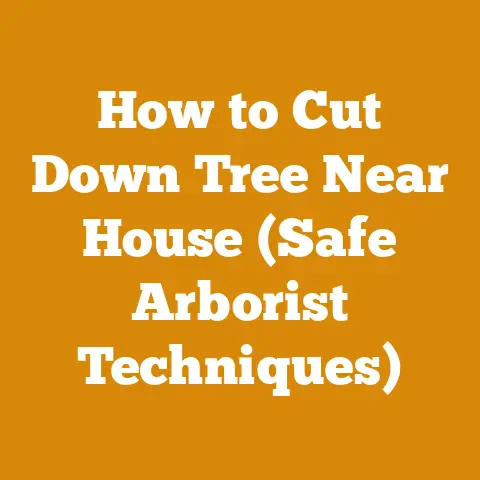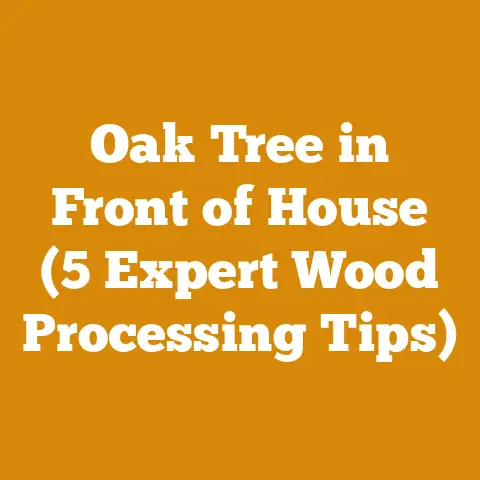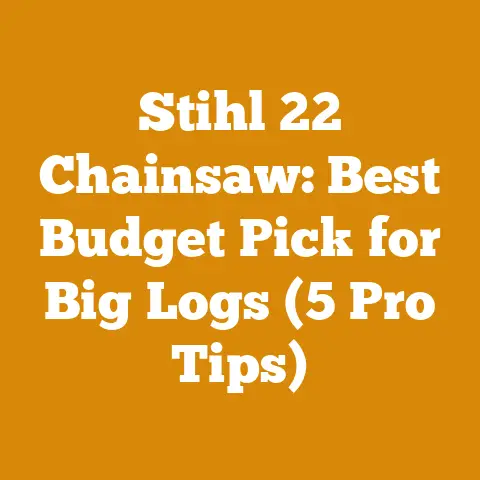Wood Chipper Machines: Are They Worth It? (Expert Arborist Review)
The Allure of the Wood Chipper: More Than Just Getting Rid of Branches
Before diving into the nitty-gritty of costs, let’s acknowledge the undeniable appeal of a wood chipper.
The ability to transform piles of unruly branches into manageable, usable wood chips is a powerful draw for homeowners, landscapers, and, of course, arborists like myself.
But the benefits extend beyond mere tidiness.
- Mulch Production: High-quality mulch is invaluable for gardens, landscaping projects, and even erosion control.
Wood chippers turn waste into a resource. - Reduced Waste Disposal Costs: Hauling away brush and branches can be surprisingly expensive, especially after a large storm or tree removal project.
A chipper significantly reduces the volume of waste, saving you money on disposal fees. - Soil Enrichment: Wood chips decompose over time, enriching the soil with valuable organic matter.
- Firewood Preparation Aid: While not their primary function, some chippers can handle smaller diameter wood suitable for kindling.
- Increased Efficiency: For professional arborists and landscapers, a wood chipper streamlines operations, allowing for faster cleanup and increased productivity.
Decoding the Price Tag: Types of Wood Chippers and Their Costs
The first layer to peel back is the initial investment.
Wood chippers come in a wide range of sizes, power levels, and price points.
Understanding the different types is crucial for making an informed decision.
- Electric Wood Chippers: These are typically the most affordable option, ranging from $100 to $500.
They are best suited for light-duty tasks, such as chipping small branches and leaves.
Power typically ranges from 1.5 to 2.5 HP. - Gas-Powered Wood Chippers: These offer more power and portability, making them suitable for larger properties and heavier workloads.
Prices range from $500 to $5,000+, depending on the engine size, chipping capacity, and features.
Engine sizes typically range from 5 HP to 20+ HP. - PTO Wood Chippers: These are designed to be powered by the power take-off (PTO) of a tractor.
They are a good option for those who already own a tractor and need a high-capacity chipper.
Prices range from $1,500 to $10,000+. - Hydraulic Self-Feeding Wood Chippers: These are the most powerful and efficient type of wood chipper, capable of handling large-diameter branches and even small trees.
They are also the most expensive, with prices ranging from $5,000 to $50,000+.
These are commonly used by professional arborists and logging companies.
Here’s a table summarizing the different types and their approximate cost ranges:
My Personal Experience: I remember my early days as an arborist, struggling with an underpowered electric chipper.
It was fine for small twigs, but anything larger than an inch in diameter would bog it down.
I quickly learned that investing in the right tool for the job is crucial.
Eventually, I upgraded to a gas-powered chipper with a larger engine, and the difference in productivity was night and day.
Beyond the Purchase Price: Hidden Costs of Wood Chipper Ownership
The initial price tag is just the tip of the iceberg.
Owning a wood chipper involves a range of ongoing expenses that can significantly impact its overall cost-effectiveness.
- Fuel Costs: Gas-powered chippers consume fuel, and the amount of fuel they consume depends on the engine size and the workload.
A chipper with a 10 HP engine might consume 0.5 to 1 gallon of fuel per hour, while a larger chipper with a 20 HP engine could consume 1 to 2 gallons per hour.
At today’s fuel prices, that can add up quickly. - Maintenance Costs: Wood chippers require regular maintenance, including oil changes, air filter replacements, spark plug replacements, and blade sharpening.
The cost of maintenance can vary depending on the type of chipper and the frequency of use.
I typically budget around $100 to $300 per year for maintenance on my gas-powered chipper. - Blade Sharpening/Replacement: Dull blades are a major cause of inefficiency and can even damage the chipper.
Blades need to be sharpened regularly, and eventually, they will need to be replaced.
Sharpening can cost $20 to $50 per blade, while replacement blades can cost $50 to $200+ per set. - Storage Costs: Wood chippers can be bulky and require adequate storage space.
If you don’t have a garage or shed, you may need to rent storage space, which can add to the overall cost. - Transportation Costs: Transporting a wood chipper to different job sites can also incur costs, especially if you need to rent a trailer or pay for fuel.
- Safety Gear: Operating a wood chipper requires safety gear, including safety glasses, ear protection, gloves, and sturdy boots.
These items can add to the initial cost of ownership.
A good set of safety gear might cost around $50 to $150.
Data Point: According to a survey conducted by the Tree Care Industry Association (TCIA), the average annual maintenance cost for a commercial wood chipper is around $500 to $1,000.
Cost Breakdown Example: Let’s consider a gas-powered wood chipper that costs $2,000.
Here’s a breakdown of the potential ongoing costs over a 5-year period:
As you can see, the ongoing costs can quickly add up, potentially exceeding the initial purchase price.
The Alternative: Renting a Wood Chipper
Renting a wood chipper can be a more cost-effective option for those who only need to use one occasionally.
Rental rates vary depending on the size and type of chipper, but you can typically rent a gas-powered chipper for $100 to $300 per day.
Here’s a table comparing the costs of owning versus renting a wood chipper:
When Renting Makes Sense:
- Infrequent Use: If you only need a wood chipper a few times a year, renting is likely the more economical option.
- Limited Storage Space: Renting eliminates the need to store a bulky piece of equipment.
- Variety of Needs: Renting allows you to choose the right size and type of chipper for each specific job.
- No Maintenance Hassles: The rental company is responsible for maintaining the chipper.
My Personal Tip: When renting, be sure to inspect the chipper thoroughly before you take it.
Check the blades for sharpness, ensure all safety features are working properly, and ask the rental company for a demonstration of how to operate the chipper safely.
Labor Costs: The Human Element in Wood Processing
Whether you own or rent a wood chipper, you’ll need someone to operate it.
Labor costs can be a significant factor, especially if you’re hiring a professional arborist or landscaper.
- DIY: If you’re doing the work yourself, your labor is “free” in the sense that you’re not paying someone else.
However, it’s important to factor in the value of your time.
How much is your time worth per hour?
Is it more valuable to spend your time on other tasks? - Hiring a Professional: Arborists and landscapers typically charge $50 to $150+ per hour for their services, depending on their experience, location, and the complexity of the job.
This rate usually includes the cost of the wood chipper and other equipment. - Labor for Firewood Preparation: If you’re using the wood chipper to prepare kindling for firewood, you’ll also need to factor in the labor costs associated with splitting, stacking, and drying the firewood.
Case Study: I once worked on a project where a homeowner decided to rent a wood chipper and do the work themselves to save money.
However, they quickly realized that it was more challenging and time-consuming than they had anticipated.
They ended up hiring me to finish the job, which ultimately cost them more than if they had hired me from the start.
The Value of Wood Chips: Turning Waste into a Resource
One of the biggest advantages of owning a wood chipper is the ability to produce your own mulch.
High-quality mulch can be expensive to purchase, so making your own can save you a significant amount of money over time.
- Mulch Prices: The price of mulch varies depending on the type, quality, and location.
However, you can typically expect to pay $30 to $80 per cubic yard for mulch. - DIY Mulch Savings: If you use a lot of mulch in your garden or landscaping projects, owning a wood chipper can quickly pay for itself in mulch savings.
- Selling Excess Mulch: If you produce more mulch than you need, you can even sell the excess to neighbors or local gardeners.
Data Point: According to the National Gardening Association, the average homeowner spends $500 to $1,000 per year on gardening supplies, including mulch.
My Personal Story: I use wood chips from my chipper extensively in my own garden.
I’ve found that they help to suppress weeds, retain moisture, and improve soil health.
I’ve also experimented with different types of wood chips, and I’ve found that some species, like cedar, are more resistant to decomposition and make excellent mulch for pathways and walkways.
Species Matters: Wood Type and Its Impact on Chipping Efficiency and Mulch Quality
The type of wood you’re chipping plays a significant role in the efficiency of the process and the quality of the resulting wood chips.
- Hardwoods vs.
Softwoods: Hardwoods, like oak and maple, are generally denser and more difficult to chip than softwoods, like pine and fir.
This means that you may need a more powerful chipper to handle hardwoods effectively. - Green vs.
Dry Wood: Green wood (freshly cut) is easier to chip than dry wood, as it is more pliable.
However, green wood chips take longer to dry and may be more prone to fungal growth. - Wood with Knots and Branches: Wood with a lot of knots and branches can be more challenging to chip, as it can get caught in the chipper blades.
- Mulch Quality: The type of wood also affects the quality of the mulch.
Some species, like black walnut, contain compounds that can be harmful to certain plants.
Other species, like cedar, have natural insect-repelling properties.
Here’s a table summarizing the characteristics of different wood types for chipping:
My Insight: I’ve learned through experience that it’s best to chip wood as soon as possible after it’s been cut.
This makes the chipping process easier and reduces the risk of the wood drying out and becoming more difficult to chip.
Safety First: Protecting Yourself and Others
Operating a wood chipper can be dangerous if proper safety precautions are not taken.
It’s essential to prioritize safety to prevent accidents and injuries.
- Personal Protective Equipment (PPE): Always wear safety glasses, ear protection, gloves, and sturdy boots when operating a wood chipper.
- Clear the Area: Make sure the area around the chipper is clear of people, pets, and obstacles.
- Feed Material Properly: Never reach into the chipper hopper while it’s running.
Use a stick or branch to feed material into the chipper. - Emergency Shut-Off: Know the location of the emergency shut-off switch and how to use it.
- Read the Manual: Read and understand the chipper’s operating manual before using it.
- Training: If you’re not comfortable operating a wood chipper, seek training from a qualified professional.
Statistics: According to the Centers for Disease Control and Prevention (CDC), there are approximately 2,000 wood chipper-related injuries each year in the United States.
My Recommendation: I always recommend that anyone operating a wood chipper take a safety course.
These courses teach you how to operate the chipper safely and effectively, and they can help you to avoid accidents and injuries.
Budgeting for Wood Processing: A Practical Guide
Creating a budget is essential for managing the costs associated with wood processing.
Here’s a step-by-step guide to help you create a realistic budget:
- Assess Your Needs: Determine the scope of your wood processing project.
How much wood do you need to chip?
What are you going to use the wood chips for? - Choose the Right Equipment: Select the right type and size of wood chipper for your needs.
Consider the initial cost, ongoing costs, and rental options. - Estimate Labor Costs: Determine whether you’re going to do the work yourself or hire a professional.
If you’re hiring a professional, get quotes from several different companies. - Factor in Transportation Costs: Consider the cost of transporting the wood to the chipper and the wood chips to their final destination.
- Account for Waste Disposal Costs: If you’re not using all of the wood chips, factor in the cost of disposing of the excess.
- Create a Contingency Fund: Set aside a contingency fund to cover unexpected expenses.
I typically recommend setting aside 10-15% of the total budget for contingencies. - Track Your Expenses: Keep track of all of your expenses throughout the project.
This will help you to stay on budget and identify areas where you can save money.
Budget Example: Let’s say you’re planning a landscaping project that requires 10 cubic yards of mulch.
Here’s a potential budget:
Compared to purchasing 10 cubic yards of mulch at $50 per cubic yard ($500 total), renting a wood chipper and making your own mulch could save you $170.
Cost Optimization Strategies: Saving Money on Wood Processing
There are several strategies you can use to optimize your wood processing costs:
- Chip Wood in Bulk: Chipping wood in bulk can save you time and money.
Rent a wood chipper for a day or two and chip all of the wood at once. - Negotiate Rental Rates: Don’t be afraid to negotiate rental rates with rental companies.
You may be able to get a discount if you rent the chipper for a longer period of time. - Maintain Your Equipment: Regularly maintain your wood chipper to prevent breakdowns and extend its lifespan.
- Sharpen Your Blades: Dull blades can significantly reduce the efficiency of the chipper.
Sharpen your blades regularly to keep them in good condition. - Use Wood Chips as Mulch: Use the wood chips as mulch in your garden or landscaping projects.
This will save you money on mulch and reduce the amount of waste you need to dispose of. - Sell Excess Wood Chips: If you produce more wood chips than you need, sell the excess to neighbors or local gardeners.
- Consider Co-ops: Banding together with neighbors to purchase or rent equipment could be an option if you all have similar needs.
Regional Variations in Timber and Fuelwood Costs: A Global Perspective
It’s important to recognize that timber and fuelwood costs vary significantly depending on your location.
Factors such as transportation costs, local regulations, and the availability of wood resources can all impact prices.
- North America: Timber prices in North America tend to be relatively stable, but fuelwood prices can vary depending on the region.
In areas with cold winters, the demand for fuelwood is higher, which can drive up prices. - Europe: Timber prices in Europe are generally higher than in North America, due to stricter environmental regulations and limited wood resources.
Fuelwood prices are also high in many parts of Europe. - Asia: Timber prices in Asia vary widely depending on the country and the type of wood.
Fuelwood is a major source of energy in many Asian countries, and prices can be volatile. - Africa: Timber prices in Africa are generally low, but deforestation is a major problem in many areas.
Fuelwood is also a major source of energy, and prices can be high in urban areas.
Data Point: According to the Food and Agriculture Organization of the United Nations (FAO), the global average price of fuelwood is around $50 per cubic meter.
However, prices can range from $10 to $200+ per cubic meter depending on the region.
My Experience: I’ve worked on projects in different parts of the world, and I’ve seen firsthand how much timber and fuelwood costs can vary.
In some areas, wood is abundant and cheap, while in others, it’s a scarce and expensive resource.
Calculating Wood Volume: Board Feet and Cords Explained
Understanding how to calculate wood volume is essential for budgeting and cost management.
The two most common units of measurement for wood are board feet and cords.
Board Foot: A board foot is a unit of measurement for lumber that is 1 inch thick, 12 inches wide, and 12 inches long.
To calculate the number of board feet in a log, you can use the following formula:Board Feet = (Diameter in inches)^2 x Length in feet / 144* Cord: A cord is a unit of measurement for firewood that is 4 feet high, 4 feet wide, and 8 feet long.
A cord contains 128 cubic feet of wood.
To estimate the number of cords in a pile of wood, you can use the following formula:Cords = (Height in feet) x (Width in feet) x (Length in feet) / 128
Example: A log that is 12 inches in diameter and 10 feet long contains approximately 10 board feet of lumber.
A pile of firewood that is 4 feet high, 4 feet wide, and 8 feet long contains 1 cord of wood.
My Tip: When calculating wood volume, it’s important to account for waste.
There will always be some waste when processing wood, so it’s best to overestimate the amount of wood you need.
Drying Time Estimation: Moisture Content and Its Impact on Fuelwood
If you’re using the wood chipper to prepare kindling for firewood, it’s important to understand how to estimate drying time.
The moisture content of the wood has a significant impact on its burning properties.
- Moisture Content: Moisture content is the percentage of water in the wood.
Freshly cut wood can have a moisture content of 50% or higher. - Drying Time: The amount of time it takes for wood to dry depends on several factors, including the species of wood, the size of the pieces, the climate, and the storage conditions.
Generally, it takes at least 6 months to a year for firewood to dry properly. -
Estimating Drying Time: You can estimate the drying time of firewood using the following guidelines:
- Softwoods dry faster than hardwoods.
- Smaller pieces dry faster than larger pieces.
- Wood stored in a dry, well-ventilated area will dry faster than wood stored in a damp, poorly ventilated area.
Formula for Estimating Drying Time (Approximate):
Example: If you have freshly cut oak firewood with an initial moisture content of 50% and you want to dry it to a target moisture content of 20%, and the drying rate in your climate is approximately 5% per month, it will take approximately 6 months to dry the firewood.
My Personal Method: I use a moisture meter to check the moisture content of my firewood.
A moisture meter is a small, handheld device that measures the moisture content of wood.
They are relatively inexpensive and can be purchased at most hardware stores.
Legal Considerations: Permits and Regulations
Depending on your location, there may be permits and regulations that apply to wood processing.
It’s important to check with your local authorities to ensure that you’re in compliance with all applicable laws.
- Tree Removal Permits: In some areas, you may need a permit to remove trees from your property.
- Burning Regulations: Many areas have regulations regarding open burning.
If you’re planning to burn wood, make sure you comply with all applicable regulations. - Noise Ordinances: Wood chippers can be noisy, so it’s important to be aware of any noise ordinances in your area.
- Business Licenses: If you’re operating a wood processing business, you may need to obtain a business license.
My Advice: It’s always better to err on the side of caution and check with your local authorities before starting any wood processing project.
Actionable Takeaways and Next Steps
So, are wood chipper machines worth it?
The answer, as with most things, is “it depends.” It depends on your individual needs, your budget, and your willingness to invest the time and effort required to operate and maintain the chipper safely and effectively.
Here are some actionable takeaways to help you make the right decision:
- Assess your needs: How often will you use a wood chipper?
What size and type of wood will you be chipping? - Compare costs: Compare the costs of owning versus renting a wood chipper.
- Factor in hidden costs: Don’t forget to factor in the ongoing costs of fuel, maintenance, and storage.
- Consider labor costs: Will you be doing the work yourself, or will you be hiring a professional?
- Prioritize safety: Always prioritize safety when operating a wood chipper.
- Create a budget: Create a realistic budget to manage your wood processing costs.
- Explore cost optimization strategies: Look for ways to save money on wood processing.
- Check local regulations: Ensure that you’re in compliance with all applicable laws.
Next Steps:
- Research different wood chipper models: Read reviews, compare features, and get quotes from different dealers.
- Visit a rental company: Check out the wood chippers they have available for rent and ask about rental rates and safety procedures.
- Talk to other arborists or landscapers: Get their opinions on the pros and cons of owning versus renting a wood chipper.
- Create a budget: Develop a detailed budget that includes all of the costs associated with wood processing.
- Make a decision: Based on your research and budget, decide whether a wood chipper is the right investment for you.
Ultimately, the decision of whether or not to invest in a wood chipper is a personal one.
By carefully considering the costs, benefits, and safety implications, you can make an informed decision that is right for you.
Remember to layer all the information presented here to make an informed decision and choose the best option for your needs.
Good luck, and happy chipping!






